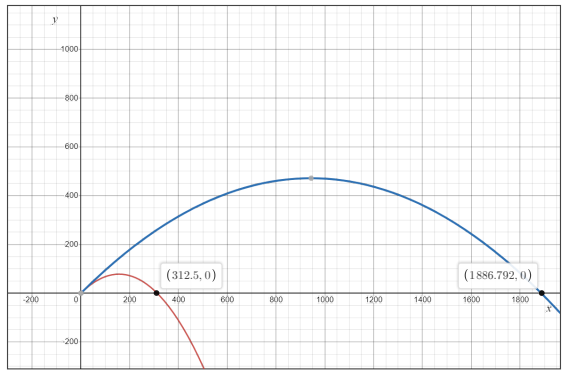
Concept explainers
a.
To find: The functions for the path of the ball hit on earth and on moon.
The functions for the path of the ball on Earth is
Given information:
The path of a ball hit an angle
Concept used:
Substitute the value of acceleration due to gravity to find the functions on different grounds.
Calculation:
Substitute
Now, substitute
Conclusion:
The functions for the path of the ball on Earth is
b.
To find: Graph the functions obtained in part (a) and, then find the distances travelled by the ball on Earth and on moon.
Graphs of the functions can be given as shown below.

The maximum distance travelled by the ball on Earth is 312.5 feet and on moon is 1886.792 feet.
Given information:
The path of a ball hit an angle
Concept used:
The maximum distance of the ball whose path is given by a quadratic function is the distance between the x-intercept of the graph.
Calculation:
Use graphing calculator to graph the functions for the path of the ball on Earth and on moon.

The red curve shows the path
Observe that x-intercept of the function
So, the maximum distance travelled by the ball on Earth is 312.5 feet and on moon is 1886.792 feet.
Conclusion:
The maximum distance travelled by the ball on Earth is 312.5 feet and on moon is 1886.792 feet.
c.
To interpret: The distance travelled by the ball on Earth and on the moon in terms of the ratio of the distances traveled and how the distances and values of
The distance traveled by the ball on Earth is less than the distance traveled on the moon as the acceleration due to gravity on Earth is higher than that of the moon.
Given information:
The path of a ball hit an angle
Concept used:
The maximum distance of the ball whose path is given by a quadratic function is the distance between the x-intercept of the graph.
Calculation:
Find the ratio of the distance traveled by the ball on Earth to the distance traveled on moon.
Observe that
The acceleration due to gravity on Earth is higher than the acceleration due to gravity on the moon. This shows that higher the acceleration due gravity less is the distance traveled.
Conclusion:
The distance traveled by the ball on Earth is less than the distance traveled on the moon as the acceleration due to gravity on Earth is higher than that of the moon.
Chapter 1 Solutions
Algebra 2: New York Edition (holt Mcdougal Larson Algebra 2)
- 8) Solve the given system using the Gaussian Elimination process. 2x8y = 3 (-6x+24y = −6arrow_forward7) Solve the given system using the Gaussian Elimination process. (5x-4y = 34 (2x - 2y = 14arrow_forward33 (a) (b) Let A(t) = = et 0 0 0 cos(t) sin(t) 0-sin(t) cos(t)) For any fixed tЄR, find det(A(t)). Show that the matrix A(t) is invertible for any tЄ R, and find the inverse (A(t))¹.arrow_forward
- Use the infinite geometric sum to convert .258 (the 58 is recurring, so there is a bar over it) to a ratio of two integers. Please go over the full problem, specifying how you found r. Thank you.arrow_forwardH.w: Find the Eigen vectors for the largest Eigen value of the system X1+ +2x3=0 3x1-2x2+x3=0 4x1+ +3x3=0arrow_forwardneed help with 5 and 6 pleasearrow_forward
- 1) Given matrix A below, answer the following questions: a) What is the order of the matrix? b) What is the element a13? c) What is the element a₁₁? 4 -1arrow_forward[25 points] Given the vector let v = ER² and the collection of vectors ε = E-{)·()}-{☹) (9)} = {(A)·(9)}· B: = and C = · {(6)·(})}· answer the following question. (a) (b) (c) (d) (e) verify Verify is a basis for R² and find the coordinate [] of under ε. Verify B is a basis for R2 and find the coordinate []B of ʊ Verify C is a basis for R2 and find the coordinate []c of under ε. under ε. Find the change-of-basis matrix [I]+B from basis B to basis ε, and EE+BUB Find the change-of-basis matrix [I]B+ε from basis Ɛ to basis B, and verify [U]B= [] B+EVEarrow_forwardExplain the following terms | (a) linear span (b) dimension of vector space (c) linearly independent (d) linearly dependent (e) rank of matrix Aarrow_forward
- 3. Let u = 3/5 √ = and = -4/5 -() Define V span{ū, }. (a) (b) (c) Show that {u, } is orthonormal and forms a basis for V. Explicitly compute Projy w. Explicitly give a non-zero vector in V+.arrow_forwardIs 1.1 0.65 -3.4 0.23 0.4 -0.44 a basis for R3? You must explain your answer 0arrow_forwardFind the values of x and y in the following scalar multiplication. 8 2 x 1 3 || y = 9 LY_ Show Calculatorarrow_forward
 Algebra and Trigonometry (6th Edition)AlgebraISBN:9780134463216Author:Robert F. BlitzerPublisher:PEARSON
Algebra and Trigonometry (6th Edition)AlgebraISBN:9780134463216Author:Robert F. BlitzerPublisher:PEARSON Contemporary Abstract AlgebraAlgebraISBN:9781305657960Author:Joseph GallianPublisher:Cengage Learning
Contemporary Abstract AlgebraAlgebraISBN:9781305657960Author:Joseph GallianPublisher:Cengage Learning Linear Algebra: A Modern IntroductionAlgebraISBN:9781285463247Author:David PoolePublisher:Cengage Learning
Linear Algebra: A Modern IntroductionAlgebraISBN:9781285463247Author:David PoolePublisher:Cengage Learning Algebra And Trigonometry (11th Edition)AlgebraISBN:9780135163078Author:Michael SullivanPublisher:PEARSON
Algebra And Trigonometry (11th Edition)AlgebraISBN:9780135163078Author:Michael SullivanPublisher:PEARSON Introduction to Linear Algebra, Fifth EditionAlgebraISBN:9780980232776Author:Gilbert StrangPublisher:Wellesley-Cambridge Press
Introduction to Linear Algebra, Fifth EditionAlgebraISBN:9780980232776Author:Gilbert StrangPublisher:Wellesley-Cambridge Press College Algebra (Collegiate Math)AlgebraISBN:9780077836344Author:Julie Miller, Donna GerkenPublisher:McGraw-Hill Education
College Algebra (Collegiate Math)AlgebraISBN:9780077836344Author:Julie Miller, Donna GerkenPublisher:McGraw-Hill Education





